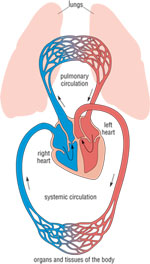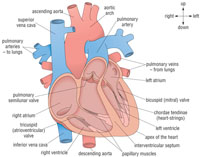Use 'Print preview' to check the number of pages and printer settings.
Print functionality varies between browsers.
Printable page generated Friday, 26 April 2024, 5:43 PM
Non-Communicable Diseases, Emergency Care and Mental Health Module: 1. Cardiovascular Diseases
Study Session 1 Cardiovascular Diseases
Introduction
This study session is the first in the Module on Non-Communicable Diseases, Emergency Care and Mental Health. Part 1 of the Module describes some important physical diseases and impairments, and the emergency care that you may be called upon to give to someone with a life-threatening condition. Part 2 covers the mental health issues that you may meet in your community. Although this first study session deals with one particular group of physical illnesses (the cardiovascular diseases), it introduces several themes that are shared by all chronic (long-term) conditions, including diabetes, cancers, lung diseases, visual impairment, deafness and other physical disabilities. As you will see, all of these conditions can affect the patient’s mental health.
Cardiovascular diseases are a major problem all over the world, including in developing countries such as Ethiopia. They are in the top three killers in almost every country. In this study session you will learn about cardiovascular diseases, beginning with the function and composition of blood, the anatomy and physiology of the heart and the blood vessels, the pulse, and the blood pressure. We will then describe the major cardiovascular diseases (hypertension and heart failure), and the community approach to decreasing the risks of these conditions. Finally we describe how you can help people with cardiovascular diseases by advising them about their diet.
Learning Outcomes for Study Session 1
When you have studied this session you should be able to:
1.1 Define and use correctly all of the key words printed in bold. (SAQs 1.1 and 1.2)
1.2 Briefly describe the function and composition of blood. (SAQ 1.1)
1.3 Describe the basic anatomy and physiology of the heart at a level sufficient to support your understanding of cardiovascular diseases in your community. (SAQs 1.2 and 1.3)
1.4 Know how to measure the pulse and blood pressure. (SAQ 1.4)
1.5 Describe the signs and symptoms of hypertension and heart failure, and the risk factors for these conditions. (SAQs 1.4 and 1.5)
1.6 Describe the management of hypertension and heart failure that you will provide for your community, including supportive care for stress and depression, and recommended diet. (SAQs 1.4 and 1.5)
1.1 Function and composition of blood
We begin this study session by describing the function of blood. The blood is considered by some to be the very essence of life itself. Before modern medicine, blood was viewed as magical. Today, blood still has enormous importance in the practice of medicine. Clinicians examine it more often than any other tissue when trying to determine the cause of a disease or a disorder.
In an adult human, blood accounts for approximately 7–9% of body weight. So for a person weighing 70 kg, some 5 to 6 litres of blood circulate around the body. The blood transports nutrients, oxygen and waste molecules from one place to another within the body.
Every living cell needs a continuous supply of oxygen and nutrients, and a means to remove waste products. Performing these needs is the primary function of the blood.
1.1.1 Blood cells and plasma
Blood is a fluid comprising red blood cells (see Figure 1.1), several types of white blood cells and small fragments of blood cells called platelets, which are involved in the blood clotting process. These cells are all suspended in yellowish or straw-coloured liquid called plasma. The red blood cells contain a protein called haemoglobin, which is red in colour and contains a lot of iron. The haemoglobin picks up oxygen as the blood passes through the lungs and distributes it around the body.
The blood cells all have medical names, but in this module we will use the names that will mean more to your clients. But for your own information, the medical name for red blood cells is erythrocytes and for white blood cells it is leukocytes.
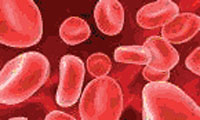
What do you think is the main function of the red blood cells?
To transport oxygen and deliver it to the body’s tissues. It is the haemoglobin in the red blood cells that plays a central role in delivering oxygen to the tissues of the body.
White blood cells are cells of the immune system involved in defending the body against infectious diseases. The number of white blood cells increases whenever someone is infected by disease-causing bacteria or viruses; the increase in number shows how seriously the disease is being fought against by the white blood cells.
The number of red blood cells and white blood cells and the concentration of haemoglobin is an important indicator of a person’s health. The levels can be determined from a blood sample analysed at the higher health facilities, including counting the cells by looking at them with a microscope. Table 1.1 shows the typical values for a healthy person.
| Blood component | Healthy values |
|---|---|
| Red blood cells | Male 4.3–5.9 x 1012/litre Female 3.5–5 x 1012/litre Or approximately 300 to 600 million red blood cells in every 1 ml of blood plasma (1012 is a mathematical abbreviation for 1,000,000,000,000.) |
| White blood cells | 3.8–9.8 x 109/litre Or approximately 400 to 1,000 million white blood cells in every 1 ml of blood plasma |
| Haemoglobin | Male 13.8–17.5g/decilitre Female 12.1–15.3g/decilitre Every 1 ml of blood contains between 1–2 grams of haemoglobin One decilitre is one-tenth of a litre (the same as 100 ml). |
1.2 Anatomy and physiology of the heart
The heart is the source of power, the pump that drives blood through the network of blood vessels throughout the body. Together the heart and blood vessels form the cardiovascular system. In fact, the heart consists of two pumps that serve two separate systems of blood vessels: the pulmonary circulation, which goes through the lungs, and the systemic circulation, which goes through the rest of the body (see Figure 1.2).
1.2.1 The circulation of blood
The heart is a large four-chambered muscular bag on the left side of the chest. In order to appreciate how the heart works, remind yourself of the primary function of the cardiovascular system: to deliver oxygen and nutrients and to remove carbon dioxide and other waste products. When you breathe in, the lungs are filled with air, of which about 21% is oxygen. To collect this oxygen, the blood has to be pumped through the lungs by the heart.
Oxygenated blood (blood rich in oxygen) from the lungs, which is bright red because oxygen has bound to the haemoglobin, returns to the heart and is then pumped around the body to supply the tissues. Blood returning from the body to the heart is rich in waste products such as carbon dioxide and is short of oxygen. This oxygen-depleted blood (dark red in colour) is termed deoxygenated blood and is pumped through the lungs again to release carbon dioxide and, of course, to collect more oxygen.
The design of the heart and associated blood vessels ensures that blood going to the lungs is kept separate from that going around the body. The heart prevents the mixing of oxygenated blood with deoxygenated blood by using two separate but parallel circuits of blood vessels: the pulmonary circulation and the systemic circulation.
Because of its four-chamber design, the heart can serve both circuits at once, using its two pumps to simultaneously push blood from one circuit through one half of its structure and blood from the other circuit through its other half (see Figure 1.3).
The muscular part of a heart is called the myocardium (‘myo-’ means ‘muscle’ and ‘-cardium’ means ‘of the heart’). The heart muscles are very special because they keep beating (contracting and relaxing) spontaneously throughout our whole lives without any conscious decision from us to make them beat.
As you can see from Figure 1.3, the heart is shown in cross-section, illustrating the position of the atria, ventricles and major veins and arteries. The left and right sides of the heart are separated by a muscular wall (called the septum), and each side is divided into a small chamber, the atrium (plural, atria), and a larger chamber, the ventricle (plural, ventricles). The atria are connected to the ventricles via a valve that ensures a one-way flow of blood. Deoxygenated blood returns from the body through two main ‘great’ veins, the inferior and superior vena cava (superior means ‘at the top’ and inferior means ‘at the bottom’ as you can see from their positions in Figure 1.3).
The atrium is a thin-walled chamber that expands with little resistance as the blood enters. Blood from the right atrium flows down into the right ventricle, through the tricuspid valve. You can imagine the valve operating in a manner similar to a swing door that only opens in one direction. When blood enters the right atrium, the valve opens and blood flows into the right ventricle. When the ventricles contract, the back pressure of the blood forces the valve to close to prevent any backflow of blood into the atria.
1.2.2 The heartbeat
What is a heartbeat? In the previous section we have been using the terms pumping, beating and contracting of the heart. You have learnt also that the heart is a muscular organ which beats all the time in our life. If you want to hear how your own heart beats you could use your stethoscope, or place your ear against the left side of someone else’s chest around the nipple on the left side in men and under the left breast in women. The heart has got a special property to beat in a coordinated manner, and a normal heart beats between 60-80 beats per minute.

1.2.3 The blood vessels
There are five types of blood vessels (see Figure 1.4):
- Artery (plural arteries) is subjected to higher blood pressure than any other vessels and the blood flow in them ‘pulses’, meaning that the blood pressure and the rate of blood flow vary with the pumping action of the heart. Arteries have layers of muscular and elastic tissue in their walls, which allows the vessels to expand with the contraction of the heart, and contract again as the heart refills with blood.
- Arterioles are smaller vessels that distribute the blood into the network of capillaries (capillary beds). They too have layers of muscle in their walls; this is very important, because it controls how much blood goes into the capillaries.
- Capillaries are the smallest blood vessels in the body, having an internal diameter hardly larger than the diameter of a single red blood cell.
- Venules collect blood from the capillary networks. The blood pressure in these vessels is low, and they do not pulse.
- Veins are the larger collecting vessels. They may run deep in tissues such as muscles, or superficially, just beneath the skin. Veins have valves to prevent the blood from running backwards or pooling.
1.2.4 The pulse
The pulse is a pressure wave of the heart that travels along the arteries and arterioles every time the left ventricle contracts and forces blood out. It can be felt where an artery can be pressed against a bone. You can do this most easily by feeling the big artery on the left or right side of the neck, or the artery in the wrist (see Figure 1.5). The pulse rate measured at the wrist is about 60 to 80 beats per minute. If the pulse rate is less than 60 beats/minute, the pulse is considered to be ‘slow’, and if it is more than 80 beats/minutes it is considered to be a fast pulse.
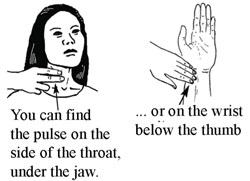
1.2.5 Blood pressure (BP)
Blood pressure (BP) refers to how hard the blood is pushing on the major blood vessels as it is pumped around the body by the heart. It is measured in millimetres (mm) of mercury (a liquid silver metal, which has the chemical symbol Hg), so blood pressure measurements are expressed as a number followed by mmHg. The technique of measuring blood pressure (Figure 1.6) was described first in the Antenatal Care Module, Study Session 9, and you have learned it in your practical skills training. Figure 1.7 reminds you how to measure the blood pressure at two points in time: when the heart contracts and when it relaxes.
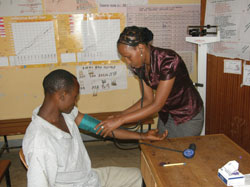
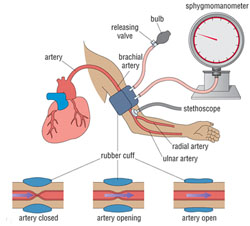
A blood pressure measurement is two numbers written one above the other. The top number tells you the systolic pressure, which is the pressure at the moment the heart beats and pushes blood into the body. The bottom number tells you the diastolic pressure when the heart relaxes between each beat so it can refill with blood. Healthy blood pressure stays at or above 90/60 mmHg, but should not reach as high as 140/90 mmHg.
1.3 What are cardiovascular diseases (CVDs)?
Cardiovascular diseases (CVDs) are major health problems all over the world. They are a group of diseases that involve the heart and the blood vessels (arteries and veins).
If there is an interruption of blood supply due to diseases of the vessels taking blood to the heart, the heart might be seriously damaged due to lack of oxygen and nutrients to fuel its muscular contractions. Medically this damage is referred to as a heart attack. If the same type of situation happens in the brain, and lack of oxygen disrupts the normal function of the brain, this is referred to as a stroke.
Heart attacks and strokes are usually acute life-threatening events (‘acute’ means they start suddenly and rapidly get worse). They are mainly caused by a blockage that prevents blood from flowing to parts of the heart or brain, which are seriously damaged by the lack of oxygen. The most common reason for the blockage is a build-up of fatty deposits (called plaques) on the inner walls of the blood vessels that supply the heart or brain. Strokes can also be caused by bleeding from a blood vessel in the brain or from blood clots blocking an artery.
1.3.1 What are the risk factors for cardiovascular diseases?
The most important risk factors for heart disease and stroke are unhealthy diet, physical inactivity and tobacco use. These are called behavioural risk factors because they are due to people’s behaviour; these factors are responsible for about 80% of cardiovascular diseases.
The effects of unhealthy diet and physical inactivity may show up in individuals as raised blood pressure, raised blood glucose, raised blood fats (lipids), and being overweight or obese – all of which make a heart attack or stroke more likely.
Can you explain why?
High fat, high sugar diets, being overweight and obesity lead to the build up of the fatty deposits (plaques) inside blood vessels that eventually block them, causing a heart attack or stroke.
Unhealthy diet is one direct cause of CVDs but there are also indirect reasons why people might be unable to eat healthily, or avoid stress and other direct causes of CVDs. These are the social, economic and cultural conditions of people’s lives, especially poverty and stress.
As a Health Extension Practitioner you should advise your community members to engage in regular physical activity, avoid tobacco use, choose a diet rich in fruit and vegetables and avoiding foods that are high in fat, sugar and salt, and maintain a healthy body weight. You might say that rural people exercise all the time in the fields and fetching water; their diet has very little fat or sugar, and they are usually thin. So why are they at risk of heart disease? The reason is stress factors in the lives of people who have few resources. And if rural people move into towns, the other risk factors for CVDs increase.
1.3.2 Heart failure
Heart failure is when the heart cannot pump efficiently and is unable to generate sufficient blood flow to meet the demands of the body for oxygen and nutrients, either at rest or during exercise.
Acute heart failure occurs rapidly, typically as a result of heart attack. Chronic heart failure occurs more slowly, building up through time due to disease of the heart or blood vessels leading from the heart.
Symptoms of heart failure
A person with heart failure is usually short of breath even when sitting still; they breathe faster than normal and may ‘gasp’ for breath if they do anything that requires strength or movement. They often cannot sleep without using many pillows because, if they lie down, the blood that cannot be pumped away from the heart collects in the vessels in the chest, which makes them even more breathless. They also complain of tiredness and weakness.
Can you suggest why people with heart failure gasp for breath and feel tired and weak?
 If you come across a person with the symptoms of heart failure, refer him or her to the nearest health centre as soon as possible.
If you come across a person with the symptoms of heart failure, refer him or her to the nearest health centre as soon as possible.The weak heart cannot supply the body with the oxygen it needs, so the person breathes quickly to try to suck more oxygen into their lungs. They feel tired and weak because there isn’t enough oxygen or nutrients being pumped around the body.
1.3.3 Hypertension (high blood pressure)
High blood pressure is medically known as hypertension. There are many causes of hypertension, including kidney diseases, narrowing of the aorta (the biggest artery leaving the heart), diabetes, the excessive use of alcohol and some medical drugs. However, in most cases of hypertension the cause remains unknown and this is called essential hypertension.
Can you name any other causes of hypertension from a previous Module?
Pre-eclampsia and eclampsia were described in the Antenatal Care Module.
Risk factors for hypertension
Having a high level of fat (cholesterol) in the blood, old age, poor nutrition, being overweight or obese, excessive alcohol intake, diabetes, taking oral contraceptive pills for many years, being physically inactive and, most importantly, being a cigarette smoker – are all risk factors for hypertension. Most of these factors are preventable by teaching the community to change their behaviour to healthier ways.
What could a person stop doing in order to reduce their risk of developing hypertension?
He or she could stop smoking cigarettes, stop over-eating and drinking excessive amounts of alcohol, and (for women) stop taking oral contraceptive pills and change to another method of birth control after a few years.
What could a person start doing in order to reduce the risk?
He or she could start eating a healthier diet, start losing weight if already obese, and start taking more exercise.
Signs and symptoms of hypertension
A person with hypertension might come to you with complaints of headaches, blurring of vision, chest pain, nose bleeds and restlessness. You should measure their blood pressure to see if it is high. Refer to Table 1.2 to see the normal and abnormal blood pressure values.
In your Health Post you are supposed routinely to check the blood pressure of your clients, using the blood pressure apparatus supplied to you. Whenever the systolic pressure is greater than 140 mmHg and the diastolic pressure is greater than 90 mmHg, it is advisable to refer the person to the nearest health centre for further evaluation. See Table 1.2 to determine the category of hypertension.
| Category | Systolic (mmHg) | Diastolic (mmHg) | Advice |
|---|---|---|---|
| Normal | Less than 120 | Less than 80 | None |
| Pre-hypertension (before hypertension starts) | 120-139 | 80-89 | You should advise people with hypertension to make changes in what they eat and drink, to be physically active, and lose extra weight. If your client also has diabetes, refer him or her. |
| 140 or higher | 90 or higher | This person has high blood pressure. Refer him or her to a higher health facility. |
1.4 Community approaches to decrease the risk of cardiovascular diseases
In the community you are working in, the risk of CVDs could be reduced by advising people to reduce the salt intake in their diet, since excessive salt could cause hypertension. They should also avoid or stop smoking.
1.4.1 Action by individuals
People should also be advised to minimise the stress in their lives for three reasons. Firstly, stress is often associated with an increase in health-damaging behaviours. It is possible that people under stress might smoke more, drink more alcohol, chew khat, indulge in comfort eating and neglect any potentially protective physical activity – all of which increase their risk of developing a CVD. Secondly, there may be direct links between physiological changes that are associated with stress, such as the release of certain hormones – adrenalin and corticosteroids, for example – that might directly affect the heart and the arteries that bring oxygen to the heart muscle. Thirdly, people under stress might neglect to seek appropriate medical attention. Understanding the above will help you in resolving your clients’ cardiovascular problems.
1.4.2 Action at national and community level
In prevention of cardiovascular diseases, the habits of people within a population can, to some extent, be controlled by the actions of their government. The best example of this, particularly in relation to cardiovascular diseases, is the way in which various governments attempt tobacco control.
The most common types of government activity are through the use of taxation, by banning smoking in public places, by banning tobacco advertising and by choosing to finance health education campaigns. As a community health worker you should think of a project within your kebele to promote smoking reduction and decrease salt intake.
1.4.3 Dietary approach to stop hypertension (DASH)
An important approach to reducing hypertension is called DASH – Dietary Approach to Stop Hypertension. It advises people that high blood pressure can be controlled if you take the following steps:
- Maintain a healthy weight.
- Be moderately physically active on most days of the week.
- Follow a healthy eating plan, which includes foods lower in salt.
- If you drink alcoholic beverages, do so in moderation.
- If you have high blood pressure and are prescribed medication, take it as directed.
1.5 Mental health and chronic illness
When you are caring for somebody who has a chronic (long-term) life-threatening non-communicable disease, such as a cardiovascular disease, it is also important to think about their mental health. You will learn about mental health and mental illness in detail in Part 2 of this Module. However, you may not have thought about the stress experienced by a person who is living with a CVD, or another chronic illness, such as diabetes, cancer, a chronic respiratory disease, or a disability such as blindness, deafness or physical paralysis. Having one of these conditions is stressful for patients and their families, and their mental health can suffer. You should bear in mind that:
- People with a chronic illness may become sad or depressed about their condition. This can sometimes develop into a mental health problem, e.g. deep depression and suicidal thoughts, especially if they are in pain or their normal life is severely impaired by their illness.
- On the other hand, people with a severe mental illness are at increased risk of developing cardiovascular diseases or diabetes due to the stressful nature of their disordered mental state.
- Undetected and untreated depression can make chronic illness worse:
- Depression can interfere with a person taking their medication correctly and making important lifestyle changes, like improving their diet.
- Partly as a result of this, when depression AND chronic illness are present together, patients will be more impaired, they will not respond so well to treatment, and they may be at greater risk of dying from their chronic illness.
Therefore, detecting and treating depression and other mental health complications of chronic illness can improve the quality and the quantity of life for people with CVDs and other chronic illnesses.
In conclusion
Now that you know a lot about cardiovascular diseases, we can move on in the next session to teach you about diabetes. Dietary approaches to prevention are very similar in both conditions and diabetes is a risk factor for cardiovascular diseases, so the two are interrelated. Mental health problems can also result from the stress of managing diabetes.
Summary of Study Session 1
In Study Session 1, you have learned that:
- Cardiovascular diseases are a major cause of death and morbidity all over the world.
- Blood transports oxygen, nutrients and other substances such as hormones around the body to where they are needed, and it removes waste products, including carbon dioxide.
- Blood consists of a liquid called plasma, containing suspended red blood cells, which carry oxygen attached to haemoglobin; white blood cells, which fight infection; and platelets, which help in blood clotting.
- The heart and blood vessels (arteries, arterioles, capillaries, venules and veins) form the cardiovascular system.
- The heart pumps blood around the pulmonary circulation through the lungs (collecting oxygen and releasing carbon dioxide in the breath), and around the systemic circulation through the rest of the body. It has four chambers, which separate the oxygenated blood returning from the lungs and the deoxygenated blood returning from the rest of the body.
- The pulse refers to the pressure wave that travels along the arteries and arterioles every time the left ventricle of the heart contracts; measuring the pulse rate in the major arteries can be an indicator of an abnormal heartbeat.
- Blood pressure measurements produce two numbers: the systolic pressure measured when the heart contracts and the diastolic pressure measured when the heart relaxes. The measurement is in mmHg.
- Cardiovascular diseases include heart attack, when diseased blood vessels serving the heart muscle starve it of oxygen and nutrients; stroke, when lack of oxygen reaching the brain causes brain damage; heart failure, when the heart cannot pump efficiently; and hypertension (high blood pressure).
- The risk factors for cardiovascular diseases include being overweight, old age, poor nutrition, smoking, lack of exercise and excessive alcohol intake.
- Community approaches to reducing the risk of cardiovascular diseases include supporting people to lose weight, live a less stressful lifestyle and give up smoking, for example by using DASH – the dietary approach to stop hypertension. Reducing salt intake also helps to reduce hypertension.
- Chronic illnesses such as CVDs increase the risk of patients developing mental health problems; and people with mental health problems have a greater risk of developing a CVD or other chronic, non-communicable disease.
Self Assessment Questions (SAQs) for Study Session 1
Now that you have completed this study session, you can assess how well you have achieved its Learning Outcomes by answering these questions. Write your answers in your Study Diary and discuss them with your Tutor at the next Study Support Meeting. You can check your answers with the Notes on the Self-Assessment Questions at the end of this Module.
SAQ 1.1 (tests Learning Outcomes 1.1 and 1.2)
Which of the following statements is false? In each case, say what is incorrect.
A In an adult human, blood accounts for approximately 7–9% of total body weight.
B A person weighing 70 kg has got 10–15 litres of blood circulating around the body.
C The primary function of the blood is to transport oxygen nutrients, and as a means to remove waste products from the tissues.
D Red blood cells contain a protein called haemoglobin, which is red in colour and contains a lot of iron.
E Haemoglobin picks up oxygen as it passes through the heart and distributes it around the body in the blood.
Answer
A is true. Blood accounts for approximately 7–9% of total body weight in an adult human.
B is false. An adult has 5–6 litres of blood circulating around the body (not 10–15 litres).
C is true. The primary function of the blood is to transport oxygen nutrients, and as a means to remove waste products from the tissues.
D is true. Red blood cells contain a protein called haemoglobin, which is red in colour and contains a lot of iron.
E is false. Haemoglobin picks up oxygen as it passes through the lungs (not the heart).
SAQ 1.2 (tests Learning Outcomes 1.1 and 1.3)
Look back at Figures 1.2 and 1.3. What would happen if there was a hole in the wall that separates the two ventricles of the heart? How would this affect a baby born with such a hole in its heart? (This sometimes happens.)
Answer
If there was a hole in the wall that separates the two ventricles of the heart, the oxygenated blood returning from the lungs via the pulmonary circulation would mix with the deoxygenated blood returning from the rest of the body. When the left ventricle contracts to pump blood back to the body, it would contain a mixture of oxygenated and deoxygenated blood. In a baby born with such a hole in its heart (as sometimes happens), the body tissues and organs receive less oxygen than in a person with an undamaged heart; the baby will be more tired and breathless than a normal person.
SAQ 1.3 (tests Learning Outcome 1.4)
Where can you feel the pulse most easily in an adult? Write down the normal ranges of pulse and blood pressure in a healthy resting adult.
Answer
The pulse is most easily felt in veins on the inside of the wrist and in the neck. The normal range of the pulse is 60–80 beats per minute in a resting adult, and the normal range of blood pressure is between 90/60 mmHg and below 140/90 mmHg.
Read Case Study 1.1 and then answer the questions that follow it.
Case Study 1.1 Mr Tilahun’s story
Mr Tilahun is a 60-year-old farmer who asked you to visit him because he has begun to feel very breathless, even when he is lying in bed at night. He also feels tired and weak all the time. He was taking medication for hypertension for the past several years, but he used his last tablets three weeks ago and has not been to the health centre to get more.
SAQ 1.4 (tests Learning Outcomes 1.4, 1.5 and 1.6)
- a.What do you check first when you see Mr Tilahun?
- b.What do you think is the most likely cause of his symptoms?
- c.What measures would be appropriate for good management of his condition?
Answer
- a.The first thing to check is Mr Tilahun’s pulse rate and blood pressure to see if they are raised. If he has stopped taking medication for hypertension, it is likely that his blood pressure is too high.
- b.Heart failure is the most likely cause of his symptoms. He has had hypertension for several years, which can lead to the heart being unable to pump blood around the body efficiently. He is not getting enough oxygen or nutrients to his tissues, so he feels breathless, tired and weak.
- c.You should refer him to the nearest health centre or hospital urgently. He could have a heart attack at any time. He must begin taking medication to lower his blood pressure again soon. You should also pay attention to Mr Tilahun’s mental health – his illness may be making him depressed.
Read the following case study and then answer the question at the end:
Case Study 1.2 Mrs Yared’s story
Mrs Yared is a Health Extension Practitioner in a rural community. She notices that a lot of older people are having raised blood pressure when she gives them a health check.
SAQ 1.5 (tests Learning Outcomes 1.5 and 1.6)
What health education messages should she give to help to reduce the risk of cardiovascular diseases in her community?
Answer
She should teach people in the community that they can reduce their risk of cardiovascular diseases by:
- Eating a healthy diet, with plenty of fruits and vegetables, and low salt and fat intake
- Drinking very little alcohol
- Not smoking cigarettes
- Taking exercise every day
- Avoiding stress wherever possible
- Taking their medication regularly if their blood pressure is already raised.
